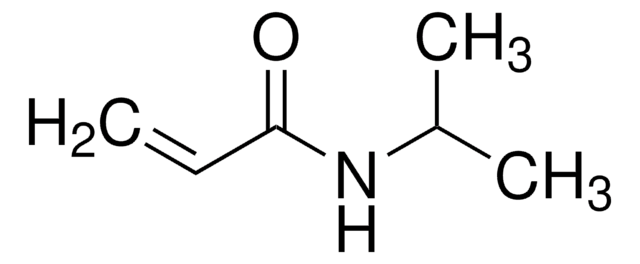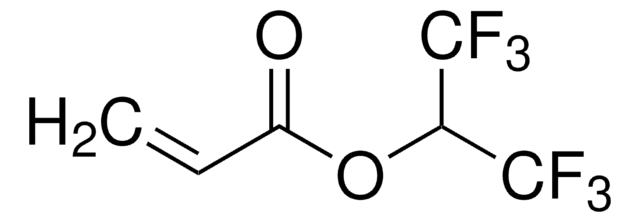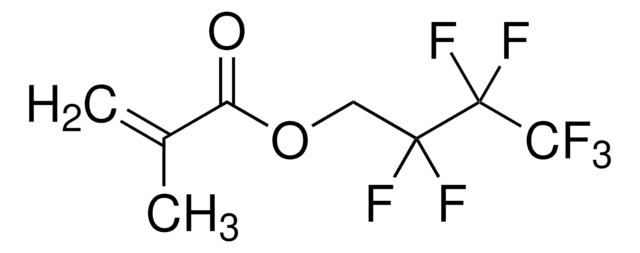474487
1H,1H,2H,2H-Perfluorodecyl acrylate
contains 100 ppm tert-butylcatechol as inhibitor, 97%
Sinónimos:
3,3,4,4,5,5,6,6,7,7,8,8,9,9,10,10,10-Heptadecafluorodecyl acrylate, 1H,1H,2H,2H-Perfluorodecyl acrylate
About This Item
Productos recomendados
Quality Level
assay
97%
contains
100 ppm tert-butylcatechol as inhibitor
refractive index
n20/D 1.337 (lit.)
bp
90 °C/4 mmHg (lit.)
density
1.637 g/mL at 25 °C (lit.)
storage temp.
2-8°C
SMILES string
FC(F)(F)C(F)(F)C(F)(F)C(F)(F)C(F)(F)C(F)(F)C(F)(F)C(F)(F)CCOC(=O)C=C
InChI
1S/C13H7F17O2/c1-2-5(31)32-4-3-6(14,15)7(16,17)8(18,19)9(20,21)10(22,23)11(24,25)12(26,27)13(28,29)30/h2H,1,3-4H2
InChI key
QUKRIOLKOHUUBM-UHFFFAOYSA-N
¿Está buscando productos similares? Visita Guía de comparación de productos
General description
Application
- As a monomer to synthesize block copolymer brushes of the [2-(methacryloyloxy)ethyl] trimethylammonium chloride (PMETAC) and poly(1H, 1H, 2H, 2H-perfluorodecyl Acrylate) (PPFDA). These polymer brushes can be used to reduce friction in microfluidic and biomedical devices.
- To prepare fluorinated block copolymers via chemical vapor deposition(CVD). These are highly transparent and hydrophobic films utilized as biocompatible coatings on optical glasses and commercial optical filters.
- As a precursor to synthesize poly(1H, 1H, 2H, 2H-perfluorodecyl acrylate) nanoparticles which can used as drug carriers and have the ability to cross the blood-brain barrier(BBB). They are utilized for the targeted transport of neuroprotective agents.
- To fabricate anti-fouling and anti-infective surface coating for medical textiles.
signalword
Danger
Hazard Classifications
Acute Tox. 4 Inhalation - Acute Tox. 4 Oral - Carc. 2 - Eye Dam. 1 - Lact. - Repr. 1B - STOT RE 1
target_organs
Liver
Storage Class
6.1C - Combustible acute toxic Cat.3 / toxic compounds or compounds which causing chronic effects
wgk_germany
WGK 3
flash_point_f
235.4 °F - closed cup
flash_point_c
113 °C - closed cup
ppe
Eyeshields, Gloves, type N95 (US)
Elija entre una de las versiones más recientes:
¿Ya tiene este producto?
Encuentre la documentación para los productos que ha comprado recientemente en la Biblioteca de documentos.
Los clientes también vieron
Nuestro equipo de científicos tiene experiencia en todas las áreas de investigación: Ciencias de la vida, Ciencia de los materiales, Síntesis química, Cromatografía, Analítica y muchas otras.
Póngase en contacto con el Servicio técnico













